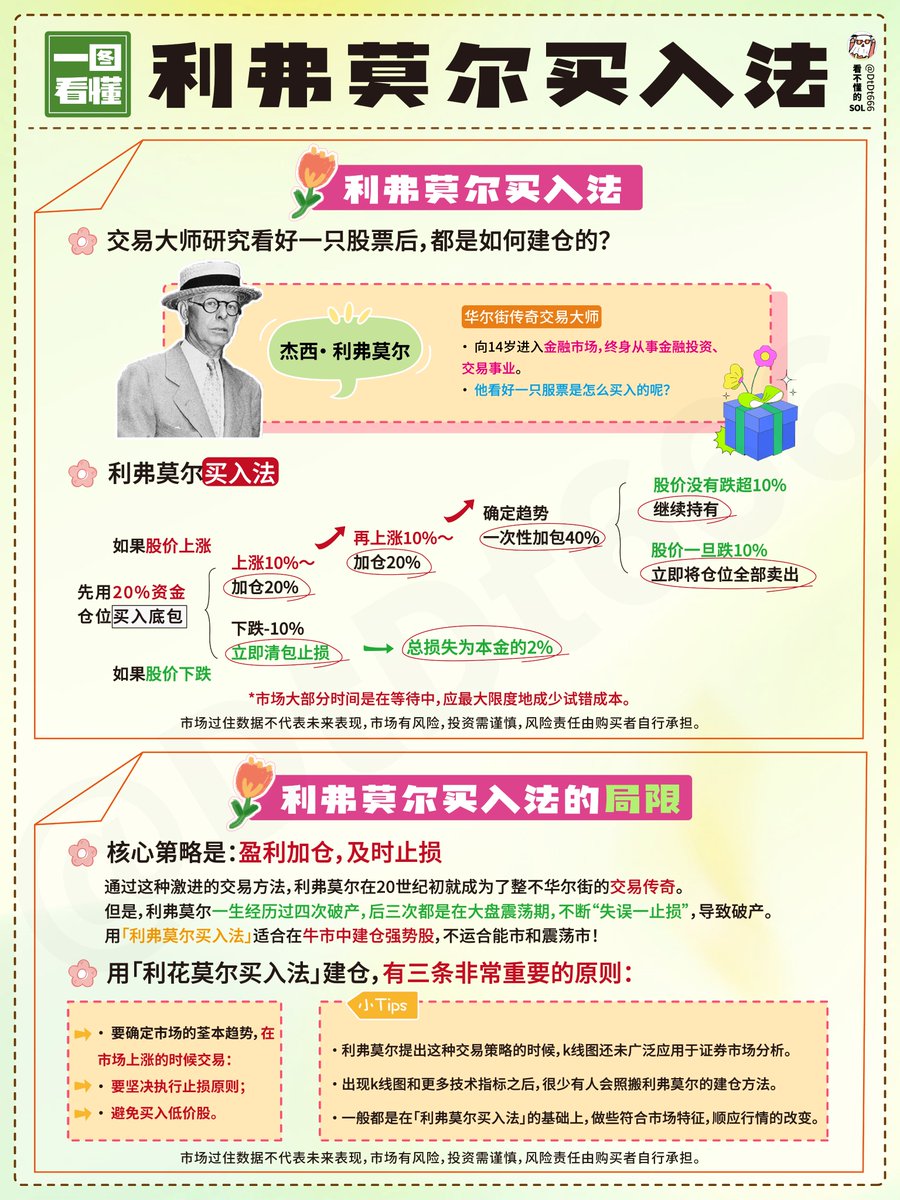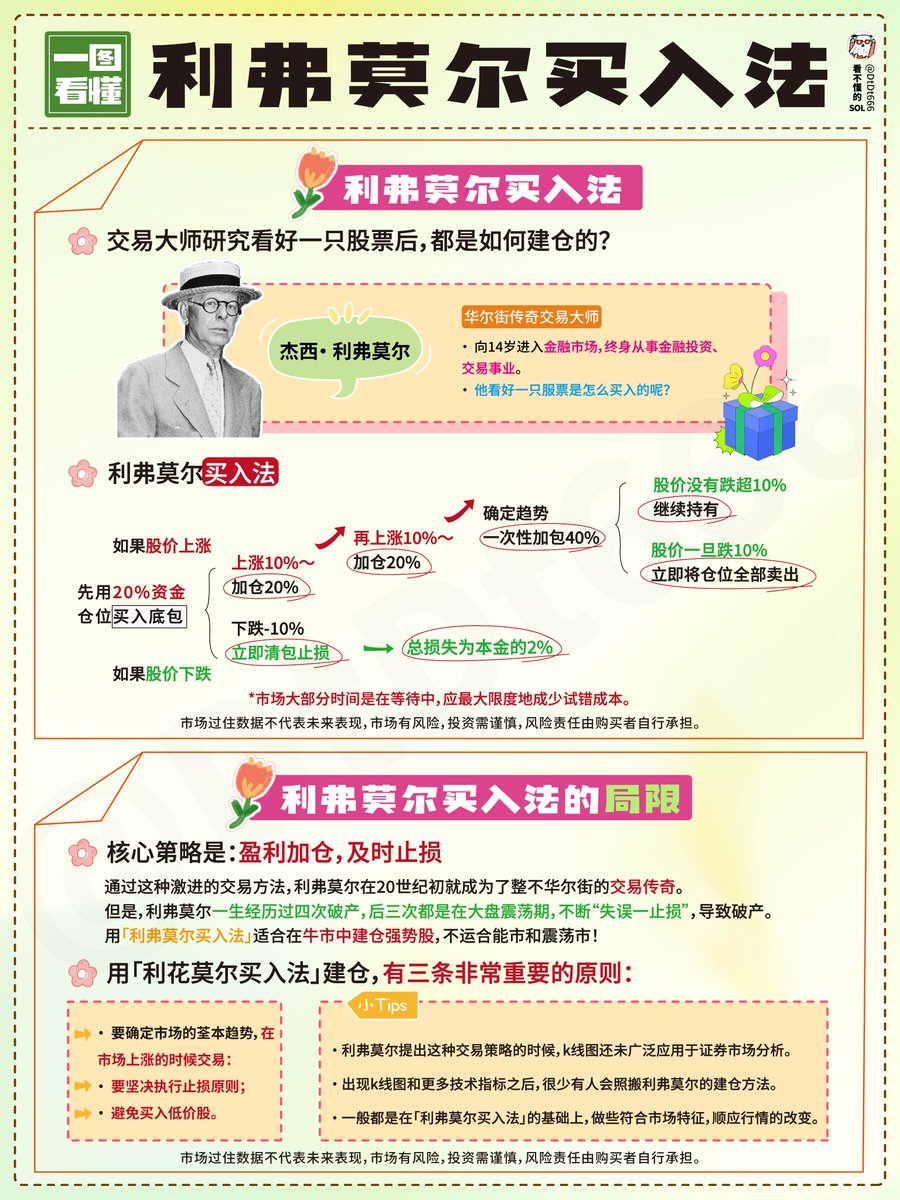A picture to understand the Kelly formula subverts your investment cognition
Why do top gamblers never all in?
Leeks generally only consider "up" or "down", and the Kelly formula tells us that we need to take these factors into account: the probability of rising, how much upside there is, how much downside there is, how much downside there is, and then calculating the position.
Let's talk about the core of Kelly's formula first, investment is probability:
Don't be greedy: even if the win rate is high, you can't "stud a handful", otherwise you may lose all your money if you fail.
Don't be conservative: if the odds are good, bet more to make more money.
Dynamic adjustment: According to the current changes in funds, bet more when there is more money, and bet less when there is less money.
Good opportunities have to be bet hard, but you have to leave enough money to withstand bad luck
The difference between buying stocks/BTC and gambling is that if you lose, you will only lose part of it, and you will not lose all of it (unless the stock/BTC price falls to 0), in this scenario, Kelly's formula is:
f = p/l - q/g
thereinto
f is the optimal proportion of the investment amount (position)
p is the probability of an increase in price (win rate)
q is the probability of price decline (q=1-p)
g is the magnitude of the price increase (upside)
l is the magnitude of the price decline (downside)
When someone tells you that you should take a stud, remember to pull out the Kelly formula and calculate what the best position should be.
The Kelly Formula is like a "smart money allocator" that helps you decide how much you should invest in each investment or gambling to maximize long-term gains and avoid the risk of bankruptcy.
Precautions
Rely on accurate predictions: If you overestimate the odds or odds, the Kelly Formula will trap you.
Avoid extreme cases: for example, the formula recommends betting more than 100%, indicating that this is a "trap" (there is no such thing as a guaranteed win).
Actual discounts: Many people use "half Kelly" (betting half of the recommended ratio) to further reduce the risk.
In one sentence
Kelly's formula teaches you - "bet heavily on good chances, but save enough money to withstand bad luck"

A picture to understand the king of speculation, Livermore's breakthrough buying method:
(1) Buy 20% first;
(2) Suppose you buy a wrong one, and immediately stop the loss if it falls by 10%, and the loss amount is 2% of the total position;
(3) Suppose you buy right, if it rises by 10%, you will immediately increase your position by 20%;
(4) If it rises by another 10%, it will immediately add another 20%;
(5) 40% directly added for the last time;
(6) Expand the victory and hold it as long as it does not fall below 10%;
(7) Once it falls by 10%, sell all positions immediately.
The essence is to find a high probability of opportunity operation, the market is waiting most of the time, and the cost of trial and error should be minimized.
However, this is suitable for building a strong coin/share in a bull market, and it is not lucky to be in a volatile market.
1️⃣ What is Jesse Livermore's core investment philosophy? Let me summarize briefly:
🔺 Trend First: He emphasizes following the market trend, believing that there is a clear bullish upward and bearish downward trend in the market, and investors should identify and follow this trend and avoid going against the trend.
🔺 Risk control: He attaches great importance to stop-loss and money management, sets stop-loss points for each trade, avoids losses from expanding, and reduces risk by diversifying investments and controlling positions.
🔺 Independent thinking and patience: He advocates independent analysis of the market, not relying on the opinions of others, and patiently waiting for the right trading time, such as the price breaking through the key resistance level or pulling back to the support level.
2️⃣ Let the Profit Run Concept
This is one of Livermore's core investment philosophies.
When a trade starts to make a profit, he will not be in a hurry to close the position for profit because of short-term price fluctuations or small pullbacks.
He believes that profits should be driven by trends to grow as much as possible, like letting a running horse gallop on a track with no obvious obstacles.
As long as the market trend does not change, a profitable position should be held until a clear reversal signal appears. This philosophy reflects his belief in trends and his pursuit of long-term investment returns.
3️⃣ Trend judgment and follow the trend
(1) Recognize the general trend
Livermore believes that making a lot of money depends on the movement of the broader market, not the volatility of individual stocks. He actively identifies the main trend and the minimum resistance line in the market, and is not limited by the stereotyped thinking of "bull market" and "bear market". For example, in 1907, it was shorted first and then long, and in 1929, it was shorted near a high price, both of which were profitable.
Follow the trend: buy in a rising market, sell in a falling market, in line with the direction of the market. When there is no obvious trend in the market, choose to wait and see, and wait for the trend to be clear before acting.
(2) Seize the opportunity
Waiting for key points: Livermore patiently waits for key points in the trade, such as buying Bethlehem Steel, and waits 6 weeks until the stock price breaks above 100 points before buying.
Act after confirming the trend: do not enter the market early, and wait for market changes to confirm the view before making a decisive attack.
(3) Fund management and position control
Tentative operation: first test a small position, such as buying 20% of the planned position, increase the position if the profit is made, and stop the loss if it reaches a certain percentage (such as a maximum of 10%).
Refuse to increase positions at a loss: Do not increase positions when you lose money to dilute costs to avoid expanding losses.
Diversification: Don't concentrate your money in one place to reduce the risk of going all-or-nothing.
(4) Strict stop-loss and take-profit
Resolute stop loss: Set a stop loss point, such as a maximum loss of 10% in a single transaction, unconditional liquidation to prevent the loss from expanding.
Let profits run: When the stock rises, don't be afraid of a pullback, think about the reason for the rise, don't rush to sell, and let the profits continue to grow.
(5) Independent thinking and reverse thinking
Independent analysis and judgment: do not easily believe the gossip, rely on your own research and decision-making. He was once damaged by listening to other people's advice, and since then he has become more independent, and even uses the grapevine in reverse.
Contrarian thinking: Suspicious of the general perception of the market and looking for trading opportunities that are contrary to the market consensus.
(6) Management of trading emotions
Stay calm and rational and avoid greed and fear from influencing decision-making. Develop a strategy before trading and strictly implement it, and do not operate blindly or trade impulsively.
3️⃣ Livermore's success story
(1) Operations in the 1907 stock market crash
- Background: In 1907, the U.S. financial markets faced a severe crisis, and the stock market fell sharply. The market environment was fraught with panic, bank runs, and many financial institutions teetering.
- Operational process: Livermore perceives the fragility of the market and the imminent collapse of the market. He started shorting stocks, borrowing them and selling them in anticipation that the stock price would fall. As the panic spreads in the market, the stock price fell sharply, as he expected. When the market falls to a certain point and is close to the bottom, he backhands and goes long. By going short and then long, Livermore made millions of dollars in profits from the stock market crisis. This not only demonstrates his accurate judgment of market trends, but also his ability to seize the opportunity to operate in reverse.
(2) Bethlehem Steel stock trading
- Background: At that time, the steel industry played an important role in economic development, and Bethlehem Steel Company was an important enterprise in the industry.
- Operational process: Livermore was very cautious in operating Bethlehem Steel stock. He waited for 6 weeks and kept watching the stock's price action and market sentiment. It wasn't until the stock price broke through the round number mark of 100 points that he thought it was a key buy signal and decided to buy. After that, with the development of the steel industry and the improvement of the company's performance, the stock price continued to rise. Livermore made a huge profit by patiently waiting for key moments and entering the market once the trend was established.
(3) The 1929 U.S. stock crash and short-selling operations
- Background: In the 20s of the 20th century, there was a huge bubble in the U.S. stock market, and there was a crisis hidden under the surface of economic prosperity. Stock prices are overvalued and market sentiment is extremely optimistic.
- Operation: Livermore, with his years of experience and keen insight, sensed that the bubble in the market was about to burst. When the stock market reached near its peak in 1929, he began to short stocks on a large scale. When the market crashed and the stock price plummeted, he made a huge profit of nearly $100 million. This operation is a classic of his trading career, demonstrating his ability to judge and act decisively, as well as his deep understanding of the overall market environment.
At its peak, Livermore had the prettiest office in all of New York, located at 730 Fifth Avenue with his dedicated elevator. Before each New Year's Day, Livermore locked himself in a private vault for three days, sitting among tens of millions of dollars in cash, scrutinizing the reasons for past failed transactions.
His life has gone through ups and downs, 4 bankruptcies, but each time he can make a comeback, which can be called a Wall Street legend; In the stock market for more than 100 years, Livermore has been doing it for nearly half a century.
On November 28, 1940, Jesse Liver, the Wall Street legend, arrived at the Shirley Holland Hotel in New York to identify his father's body. Looking at his father's body, a few minutes later, he collapsed and shot himself in the bathroom, ending his life at the age of 63.
Before he died, he left a note in scribbled handwriting: "My life is a failure. There are many comments about his life, but there is one sentence that is the most appropriate: the greatness of his life, the madness of his body. - "Memoirs of a Stock Trader"
Share!

511.76K
931
The content on this page is provided by third parties. Unless otherwise stated, OKX is not the author of the cited article(s) and does not claim any copyright in the materials. The content is provided for informational purposes only and does not represent the views of OKX. It is not intended to be an endorsement of any kind and should not be considered investment advice or a solicitation to buy or sell digital assets. To the extent generative AI is utilized to provide summaries or other information, such AI generated content may be inaccurate or inconsistent. Please read the linked article for more details and information. OKX is not responsible for content hosted on third party sites. Digital asset holdings, including stablecoins and NFTs, involve a high degree of risk and can fluctuate greatly. You should carefully consider whether trading or holding digital assets is suitable for you in light of your financial condition.

